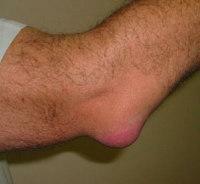 Free flexion of the limb at the elbow is possible due to the presence of a special periarticular bag - the bursa.
Free flexion of the limb at the elbow is possible due to the presence of a special periarticular bag - the bursa.
A small amount of special fluid that is contained in its cavity plays the role of lubricant, reducing friction and preventing possible micro-trauma.
If suddenly the synovial bag becomes inflamed, a disease called bursitis of the elbow joint develops, the symptoms and treatment of which we will now consider.
What it is?
Why does bursitis of the elbow joint occur, and what is it? Around the elbow there are interosseous ulnar, raybulb and ulnar subcutaneous synovial bags, which contain a little liquid, which ensures painless functioning of the joint.
If the inflammation develops in the synovial bag for one reason or another, then the amount of fluid increases, its composition, character changes, pain and other symptoms of bursitis appear.
In most cases, elbow bursitis is a consequence of an injury resulting in damage to synovial bags and infection by pathogenic agents. For example, streptococcus, staphylococcus or causative agents of syphilis, tuberculosis, gonococcus.
Causes
This pathology can occur for several reasons, the main of which are:
- The infection enters the bursa with the current of lymph and bloodfrom purulent foci in the body (furuncle, sore throat) or with influenza.
- Arthritis of any etiology- rheumatoid, psoriatic or gouty. In this case, against the background of an acute inflammatory process in the cartilage, fluid accumulation begins, which leads to the appearance of bursitis.
- Inflammation of the bursa occursafter an excessive load on the elbow joint. This is typical for athletes who play tennis and golf.
- In a number of patients, the disease develops over timeafter the mechanical injury of the elbow(for example, with a strong impact or fall on this part of the body).
Suppuration can occur due to weakened immunity, impaired metabolism in the body, as well as due to the use of steroid drugs.
Symptoms of bursitis of the elbow joint
 In the area of one of the synovial bags appears a swelling, which looks like a seal that is rather soft when probed, having a size of about 70-100 mm.
In the area of one of the synovial bags appears a swelling, which looks like a seal that is rather soft when probed, having a size of about 70-100 mm.
Elbow bursitis has other symptoms. These include:
- Edema, which appears suddenly and causes pain, and also interfere with the movements of the joint. Sometimes such an outflow can be noticed not immediately, thereby delaying the beginning of treatment.
- Gradually the synovial bag will grow in size and the inflammation will increase, and thus also painful sensations.
- A person can have a fever and the skin turns red.
Purulent bursitisIn addition to the symptoms described above, the elbow joint has microbial flora and provokes the development of purulent arthritis. In this case, the following symptoms appear:
- the body temperature rises;
- weakness, fatigue;
- nausea and / or vomiting;
- the joint area is red, very painful, tense;
- maybe even confusion and delusional syndrome with a sufficient amount of effusion,
- caused by an aggressive pathogen.
All these manifestations are characteristic not only of bursitis and can occur in other rheumatological and traumatological diseases - arthritis, epicondylitis, fractures and sprains, etc. Therefore, for the proper diagnosis of bursitis, additional methods of investigation, as well as a correctly collected history, are of great importance.
Bursitis of the elbow joint photo
As this ailment looks, we offer detailed photos to view.
Diagnostic Methods
To clarify the prevalence of the process and eliminate complications, there are a number of methods for instrumental diagnosis:
- Radiography of the joint: allows to establish the presence of the inflammatory process in the articulation.
- US of a joint: helps to specify the sizes and localization of the inflamed bag, the amount of exudate in it
- MRI of the joint: allows to diagnose bursitis of deep articular bags.
In most cases, it is not difficult to diagnose the diagnosis on the basis of the examination of the orthopedist traumatologist.
Effects
Complications of bursitis of the elbow joint are much more difficult to treat than the disease itself.
- Phlegmon. Purulent melting of the cell spaces located under the skin and between the muscles.
- Purulent arthritis. Characteristic is the transition of the disease to the joint, which is located next to the injured and limiting it in movements.
- Lymphadenitis. It is formed as a result of infection of the lymph nodes, to which lymph flows from the focus of inflammation and an abscess is formed.
Treatment of elbow bursitis
Treatment depends on the form of the ailment and everything starts with the diagnosis. If the elbow joint bursitis is not complicated and is a consequence of a minor bruise, then it can pass independently, with restriction mobility of the patient site and application of a cold compress followed by the use of dimexide as a resorbant.
Nevertheless, there are general principles of rendering assistance in this pathology:
- Immobilization of the joint. The elbow joint is fixed by means of a dressing or orthosis, which provides rest to the organ, reduces discomfort caused by movement, helps to resolve edema.
- As an emergency for acute bursitis, you can usecold compress. In chronic bursitis use compresses with honey, aloe, burdock, St. John's wort or yarrow.
- Anti-inflammatory drugs- the so-called NSAIDs. The basic group for the treatment of bursitis and all rheumatological diseases.
Purulent bursitis of the elbow joint requires a more serious approach to treatment. The patient goes to the surgeon, who carries out a puncture of the bag, rinses it and injects antibiotics and corticosteroids directly into the inflammatory focus. Further treatment continues with observance of all principles of purulent surgery, in case of severe forms it can be performed in a hospital.
Operation
Surgical intervention is carried out only in extreme cases, when all tried methods are ineffective. Most often, the operation is necessary for a recurrent bursitis, or purulent-hemorrhagic inflammation, as well as for persistent serosity.
Than to treat a bursitis in house conditions?
In an easy form, people's remedies that can be done on their own at home can help cure the elbow joint bursitis.
- Mode of application:20 g propolis per 1 glass of high-quality vodka. The resulting liquid must be mixed and allowed to stand for 1 week. After the mixture is applied to a clean gauze or bandage and applied to the inflamed place for 5-10 minutes. To achieve the effect, it is necessary to apply the compress every day for several weeks.
- Aloe with honey. This treatment is suitable for acute bursitis. Take 1 tbsp. aloe juice and 2 tbsp. honey, mix the ingredients. Fold the bandage in several layers and put the mixture on it, then apply it to the sore spot, wrap it with cellophane and fix it with a bandage on the elbow. You need to be like a compress for at least two hours.
- Infusion of celery seedsexcellently removes the inflammatory, and also strengthens the immune system. To prepare this medicine you need to pour a glass of boiling water one spoon of celery seeds. The container with the product should be tightly closed and wrapped. Insist the drug should be for several hours. Then the drug should be filtered and taken inside by a glass twice a day. Course - up to two weeks.
With a noticeable progression of the inflammatory process and the lack of effectiveness of folk remedies for more than two days, one should not get involved in self-medication

How to choose probiotics for the intestine: a list of drugs.

Effective and inexpensive cough syrups for children and adults.

Modern non-steroidal anti-inflammatory drugs.

Review of tablets from the increased pressure of the new generation.
 Antiviral drugs are inexpensive and effective.
Antiviral drugs are inexpensive and effective.



